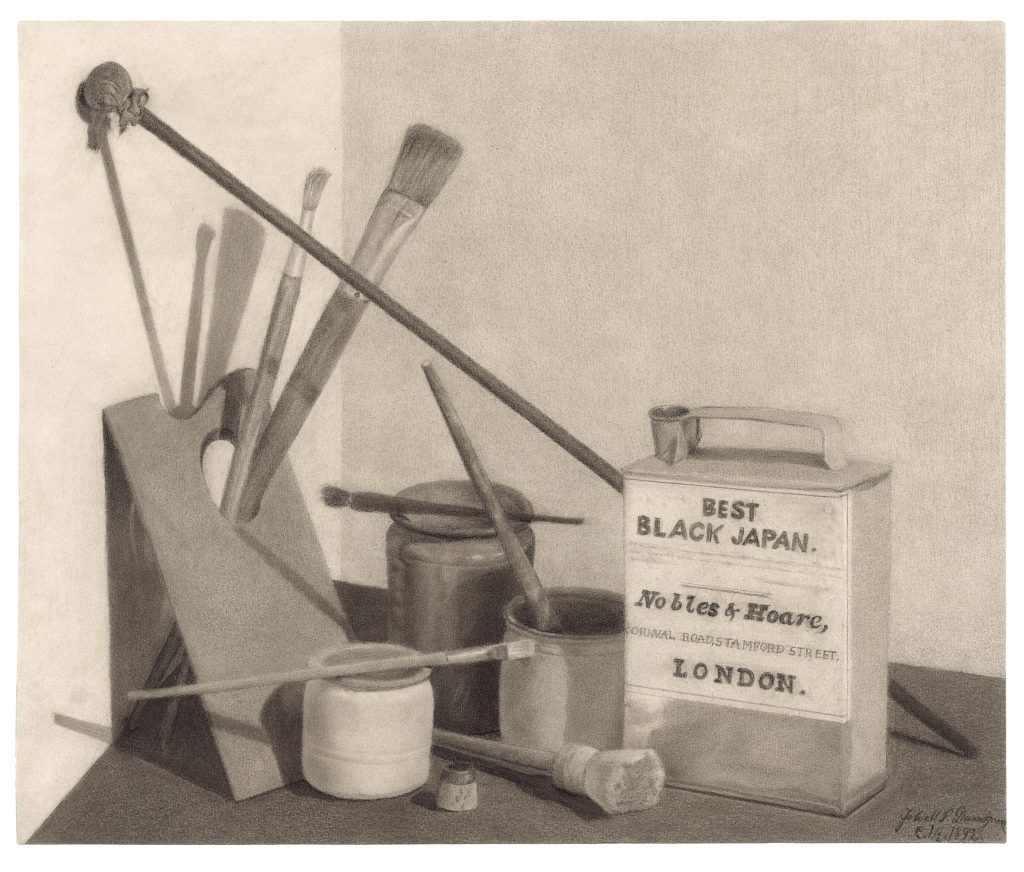This very attractive still-life remains a mystery. It feels modern, and in the other hand it is dated of 1892; it looks like a corner of an artist studio, however the refine depiction of each object makes believe that the aim of the artist was elsewhere. Technically, this work testifies excellent draughtsman skills. Each texture is depicted with subtility, and most of all, the game between light and shadows on each object creates a beautiful animation. The position of the brushes placed across the palette or on the different paint pots, such as the mahl stick against the wall, suggests a desire to present the whole equipment of a painter, and an aim for playing with adjacent light and drop shadows on the wall or brushes, giving the complete perspectives of the composition in different shades of grey. The realism of this drawing is supported by the inscription on the can of the brand « Nobles & Hoare », an English company founded in 1787 and which manufactured varnishes, Japanese enamels and colors for the railways.
The inscription in the lower right mentions the date of 1892 as well as a C. 1/2 numbering. As for the unidentified signature, it is possible to read Joh MS. Damsgaard, and “Damsgaard” is a very common surname in Denmark. It is also the name of an area of Laksevåg district of Bergen in Norway, whose spelling “Damsgård” differs slightly. It is anyway definitively a Scandinavian artist. However, we feel a lot of interactions with other Scandinavian styles and abroad. There were at the time a lot of artistic exchanges. Like the Norwegian Johan Christian Dahl and Marcus Grønvold from Bergen studied at the Academy of Fine Arts in Copenhagen; like many artists from Norway, Sweden, Denmark, Finland who travelled to France, and where they drew their inspiration under the influence of the Impressionist and Realist movements. It is precisely the Realism that inspired some artists such as the Swedish Anders Zorn or the Norwegians Hans Olaf Halvor Heyerdahl, Erik Werenskiold or Gustav Wentzel. The present still life’s aesthetic is also close in a way to the treatment of the American realism, like the artist William Harnett who made many still lives with musical instruments or various everyday objects, in the 1880’s. Although there was a large immigration from several countries of northern Europe to the United States at the end of the 19th century, we don’t know well about influences of American art in Scandinavia, even more that a large majority of American artists were also influenced by the French art scene. Nevertheless, the skilled artist was evidently impressed by these European artistic exchanges and the Realism pictorial code, initiated earlier in France by Gustave Courbet in search for reality and a raw representation of everyday life.






